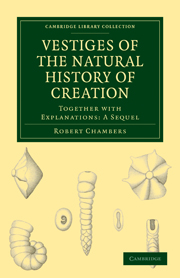Book contents
- Frontmatter
- Contents
- THE BODIES OF SPACE—THEIR ARRANGEMENTS AND FORMATION
- CONSTITUENT MATERIALS OF THE EARTH, AND OF THE OTHER BODIES OF SPACE
- THE EARTH FORMED—ERA OF THE PRIMARY ROCKS
- COMMENCEMENT OF ORGANIC LIFE—SEA PLANTS, CORALS, ETC
- ERA OF THE OLD RED SANDSTONE—FISHES ABUNDANT
- SECONDARY ROCKS—ERA OF THE CARBONIFEROUS FORMATION—COMMENCEMENT OF LAND PLANTS
- ERA OF THE NEW RED SANDSTONE—TERRESTRIAL ZOOLOGY COMMENCES WITH REPTILES—FIRST TRACES OF BIRDS
- ERA OF THE OOLITE—COMMENCEMENT OF MAMMALIA
- ERA OF THE CRETACEOUS FORMATION
- ERA OF THE TERTIARY FORMATION — MAMMALIA ABUNDANT
- ERA OF THE SUPERFICIAL FORMATIONS—COMMENCEMENT OF PRESENT SPECIES
- GENERAL CONSIDERATIONS RESPECTING THE ORIGIN OF THE ANIMATED TRIBES
- PARTICULAR CONSIDERATIONS RESPECTING THE ORIGIN OF THE ANIMATED TRIBES
- HYPOTHESIS OF THE DEVELOPMENT OF THE VEGETABLE AND ANIMAL KINGDOMS
- AFFINITIES AND GEOGRAPHICAL DISTRIBUTION OF ORGANISMS
- EARLY HISTORY OF MANKIND
- MENTAL CONSTITUTION OF ANIMALS
- PURPOSE AND GENERAL CONDITION OF THE ANIMATED CREATION
- NOTE CONCLUSORY
- APPENDIX
ERA OF THE OLD RED SANDSTONE—FISHES ABUNDANT
Published online by Cambridge University Press: 05 August 2011
- Frontmatter
- Contents
- THE BODIES OF SPACE—THEIR ARRANGEMENTS AND FORMATION
- CONSTITUENT MATERIALS OF THE EARTH, AND OF THE OTHER BODIES OF SPACE
- THE EARTH FORMED—ERA OF THE PRIMARY ROCKS
- COMMENCEMENT OF ORGANIC LIFE—SEA PLANTS, CORALS, ETC
- ERA OF THE OLD RED SANDSTONE—FISHES ABUNDANT
- SECONDARY ROCKS—ERA OF THE CARBONIFEROUS FORMATION—COMMENCEMENT OF LAND PLANTS
- ERA OF THE NEW RED SANDSTONE—TERRESTRIAL ZOOLOGY COMMENCES WITH REPTILES—FIRST TRACES OF BIRDS
- ERA OF THE OOLITE—COMMENCEMENT OF MAMMALIA
- ERA OF THE CRETACEOUS FORMATION
- ERA OF THE TERTIARY FORMATION — MAMMALIA ABUNDANT
- ERA OF THE SUPERFICIAL FORMATIONS—COMMENCEMENT OF PRESENT SPECIES
- GENERAL CONSIDERATIONS RESPECTING THE ORIGIN OF THE ANIMATED TRIBES
- PARTICULAR CONSIDERATIONS RESPECTING THE ORIGIN OF THE ANIMATED TRIBES
- HYPOTHESIS OF THE DEVELOPMENT OF THE VEGETABLE AND ANIMAL KINGDOMS
- AFFINITIES AND GEOGRAPHICAL DISTRIBUTION OF ORGANISMS
- EARLY HISTORY OF MANKIND
- MENTAL CONSTITUTION OF ANIMALS
- PURPOSE AND GENERAL CONDITION OF THE ANIMATED CREATION
- NOTE CONCLUSORY
- APPENDIX
Summary
We advance to a new chapter in this marvellous history—the era of the Old Red Sandstone System. This term is applied to a series of strata, of enormous thickness in the whole mass, largely developed in Herefordshire, Shropshire, Worcestershire, and South Wales; also in the counties of Fife, Forfar, Moray, Cromarty, and Caithness; and in Russia and North America, if not in many other parts of the world. The particular strata forming the system are somewhat different in different countries; but there is a general character to the extent of these being a mixture of flagstones, marly rocks, and sandstones, usually of a laminous structure, with conglomerates. In the conglomerates, of great extent and thickness, which form, in at least one district, the basis or leading feature of the system, inclosing water-worn fragments of quartz, and other rocks, we have evidence of the seas of that period having been subjected to a violent and long-continued agitation, probably from volcanic causes. The upper members of the series bear the appearance of having been deposited in comparatively tranquil seas. The English specimens of this system show a remarkable freedom from those disturbances which result in the interjection of trap; and they are thus defective in mineral ores. In some parts of England the old red sandstone system has been stated as 10,000 feet in thickness.
- Type
- Chapter
- Information
- Vestiges of the Natural History of CreationTogether with Explanations: A Sequel, pp. 68 - 78Publisher: Cambridge University PressPrint publication year: 2009First published in: 1844



